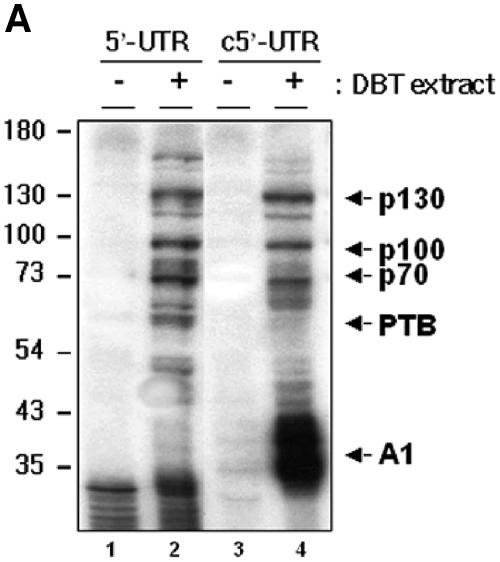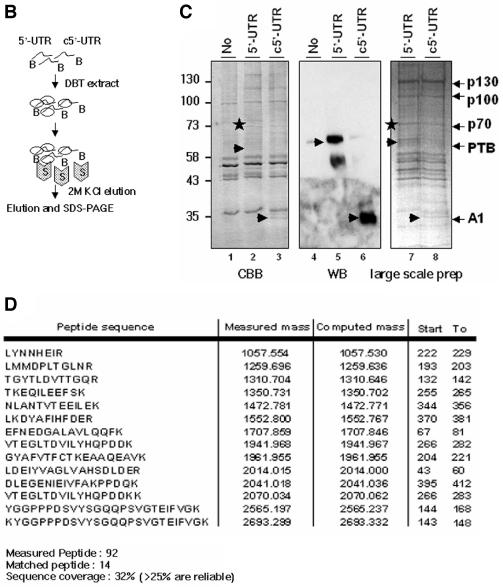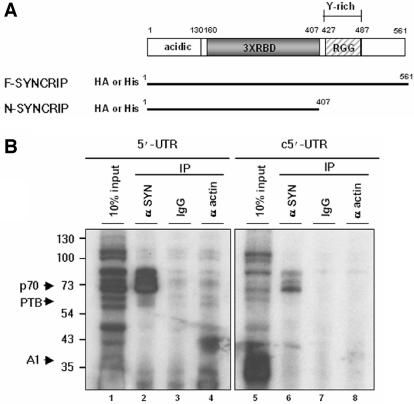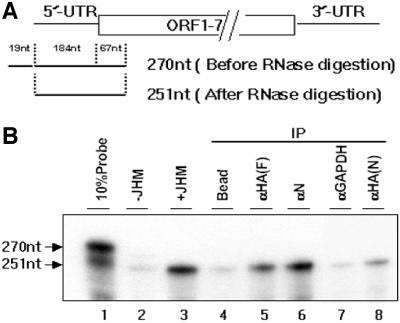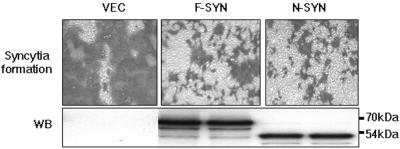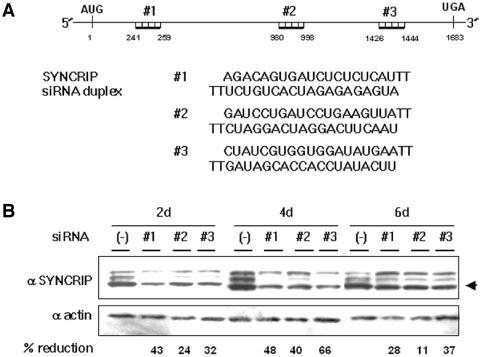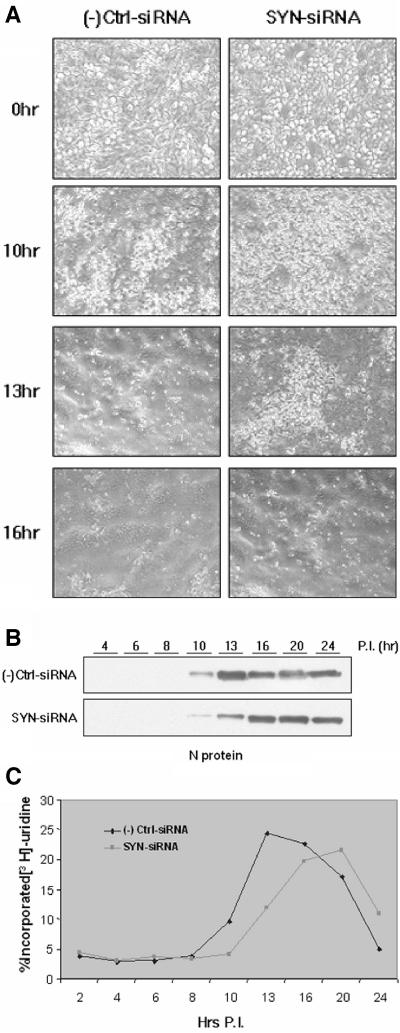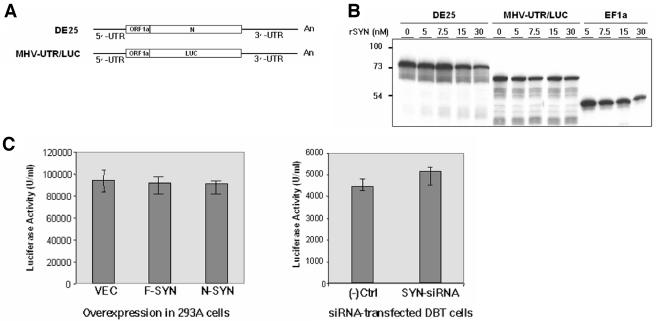Abstract
Several cellular proteins, including several heterogeneous nuclear ribonucleoproteins (hnRNPs), have been shown to function as regulatory factors for mouse hepatitis virus (MHV) RNA synthesis as a result of their binding to the 5′ and 3′ untranslated regions (UTRs) of the viral RNA. Here, we identified another cellular protein, p70, which has been shown by UV cross-linking to bind both the positive- and negative-strand UTRs of MHV RNA specifically. We purified p70 with a a one-step RNA affinity purification procedure with the biotin-labeled 5′-UTR. Matrix-assisted laser desorption ionization (MALDI)-mass spectrometry identified it as synaptotagmin-binding cytoplasmic RNA-interacting protein (SYNCRIP). SYNCRIP is a member of the hnRNP family and localizes largely in the cytoplasm. The p70 was cross-linked to the MHV positive- or negative-strand UTR in vitro and in vivo. The bacterially expressed SYNCRIP was also able to bind to the 5′-UTR of both strands. The SYNCRIP-binding site was mapped to the leader sequence of the 5′-UTR, requiring the UCUAA repeat sequence. To investigate the functional significance of SYNCRIP in MHV replication, we expressed a full-length or a C-terminally truncated form of SYNCRIP in mammalian cells expressing the MHV receptor. The overexpression of either form of SYNCRIP inhibited syncytium formation induced by MHV infection. Furthermore, downregulation of the endogenous SYNCRIP with a specific short interfering RNA delayed MHV RNA synthesis; in contrast, overexpression or downregulation of SYNCRIP did not affect MHV translation. These results suggest that SYNCRIP may be directly involved in MHV RNA replication as a positive regulator. This study identified an additional cellular hnRNP as an MHV RNA-binding protein potentially involved in viral RNA synthesis.
Mouse hepatitis virus (MHV) belongs to the Coronaviridae family and contains a single-stranded, 31-kb, positive-sense RNA (15). The viral genome is composed of a series of open reading frames (ORFs 1 to 7), flanked by untranslated regions (UTRs) at the 5′ and 3′ ends. MHV RNA replication and transcription take place in the cytoplasm and are mediated by its own RNA-dependent RNA polymerase and other viral and cellular proteins. Six to seven subgenomic mRNAs share 5′ and 3′ ends with the genomic RNA and are translated through a cap-dependent mechanism. Regulation of transcription, replication, and translation of viral RNA involves several cis- and trans-acting RNA elements, including intergenic sequence, leader sequence, and the 3′-UTR of viral RNA (19, 20, 36, 37) and viral and cellular proteins. The leader RNA can function in viral RNA synthesis both in cis and in trans in virus-infected cells (36). Several trans-acting factors, including viral and cellular proteins, have been shown to bind to this region (6).
Besides the cis- and trans-acting RNA elements, cellular proteins have been increasingly recognized to play important roles in virus replication, transcription, and translation, as well as virus entry, assembly, and release (16). For example, poliovirus translation and replication are coordinated by the interaction of host factors with viral factors at the 5′ and/or 3′ end of viral RNA. These factors include host poly(C)-binding protein, poly(A)-binding protein and the viral polymerase precursor 3CD. Poly(C)-binding protein and poly(A)-binding protein bind to the 5′ and 3′ ends, respectively, thus promoting translation early in the infection. As 3CD accumulates later in infection and binds to the cloverleaf structure in the 5′ end of viral RNA, poly(C)-binding protein, poly(A)-binding protein, and 3CD interact with each other to induce the circularization of poliovirus RNA. This circular RNP complex has been shown to be required for positive-strand RNA synthesis, thus affecting viral replication (1, 10). In addition, it has been reported that La autoantigen (22), poly(C)-binding protein, polypyrimidine tract-binding protein (PTB), and Unr (2) are involved in poliovirus internal ribosome entry site (IRES) sequence-dependent translation.
For MHV, several cellular proteins have been identified to bind to the untranslated regions of viral RNA by UV cross-linking methods (6). These include polypyrimidine tract-binding protein (PTB) (17), heterogeneous nuclear ribonucleoproteins A1 (hnRNP A1) (18), mitochondrial aconitase (25), poly(A)-binding protein (32), and several other unidentified proteins. PTB binds to the UCUAA repeat sequence within the 5′-UTR and the sequence complementary to the 3′-UTR (14, 17). PTB binding induced a conformational change in RNA structure (14). Site-directed mutagenesis of the PTB-binding site in the sequence either 5′ or complementary to the 3′-UTR inhibited the replication and transcription of MHV genomic and defective interfering RNA, suggesting that PTB may play a role in regulating viral RNA synthesis. Moreover, the study of a dominant-negative PTB mutant showed that PTB affected MHV RNA transcription and replication, but not translation (3). In contrast, hnRNP A1 binds to the leader and intergenic sequence of the negative strand and 3′-UTR region of the positive strand (18).
Mutations of the intergenic sequence that caused reduced binding of hnRNP A1 also inhibited the transcription of MHV defective interfering RNA to the corresponding extents (18, 36). The effect of hnRNP A1 on MHV RNA transcription was further confirmed in cell lines expressing a dominant-negative mutant of hnRNP A1 (29). Although MHV can replicate in cell lines deficient in hnRNP A1 (28), a recent study showed that multiple type A/B hnRNPs substituted for the functions of hnRNP A1 in these cell lines (30).
In this study, we have attempted to identify and characterize additional MHV RNA-binding proteins that interact with either the 5′-UTR or c5′-UTR of MHV. By RNA affinity purification, we were able to identify a 70-kDa, novel MHV RNA-binding protein, synaptotagmin-binding cytoplasmic RNA-interacting protein (SYNCRIP), which belongs to the hnRNP family. Our results showed that SYNCRIP binds to either MHV 5′-UTR or c5′-UTR in vitro, and the overexpressed SYNCRIP was able to bind to viral RNA in the MHV-infected cells. In an in vivo study, a truncated form of SYNCRIP with the deletion of its C terminus functioned as a dominant-negative mutant of viral replication, and delayed syncytium formation caused by virus infection. Furthermore, down-regulation of SYNCRIP by a specific short interfering RNA (siRNA) retarded syncytium formation, viral protein synthesis, and viral RNA replication. Since SYNCRIP does not have any effect on MHV RNA translation, we suggest that SYNCRIP is directly involved in MHV RNA synthesis.
MATERIALS AND METHODS
Cells, virus, and antibodies.
DBT cells, a mouse astrocytoma cell line (11), were cultured in Eagle's minimal essential medium supplemented with 7% newborn calf serum, 10% tryptose phosphate broth, and streptomycin-penicillin. The 293A cell line was cultured in Dulbecco's modified Eagle's medium supplemented with 10% fetal bovine serum. MHV-JHM was amplified in DBT cells and maintained in minimal essential medium minimal essential medium containing 1% newborn calf serum.
The polyclonal anti-SYNCRIP antibody was made in rabbits by injecting a peptide (amino acids 140 to 152) of SYNCRIP (23). Anti-PTB antibody (BB7) and anti-hnRNP A1 antibody were purchased from the American Type Culture Collection (Manassas, Va.) and Aves Labs, Inc. (Tigard, Oreg.), respectively. The monoclonal anti-hemagglutinin (HA) antibody was purchased from the microcore facility at the University of Southern California. Anti-actin antibody was obtained from Sigma (St. Louis, Mo.). The mouse monoclonal antibody against the N protein of MHV has been described previously (5).
UV cross-linking assay.
The UV cross-linking assay was performed as previously described (6). Briefly, 20 μg of DBT cytoplasmic extract was incubated for 10 min at 30°C with 20 μg of tRNA and 40 U of RNasin. Next, in vitro-transcribed and 32P-labeled (106 cpm) MHV RNA was added and incubated for 10 more minutes. Samples were placed on ice and exposed to UV in a Stratalinker (Stratagene, La Jolla, Calif.) for 10 min, followed by digestion with 400 μg of RNase A per ml for 30 min at 37°C. The protein-RNA complexes were separated by sodium dodecyl sulfate (SDS)-polyacrylamide gel electrophoresis (PAGE) and visualized by autoradiography.
RNA affinity purification.
For biotinylation of RNA, either the 5′-UTR or c5′-UTR of MHV was in vitro transcribed from pNX1-182 (6) by T7 or T3 RNA polymerase with biotin-UTP (Roche, Indianapolis, Ind.) with Maxiscript kit from Ambion (Austin, Tex.). DBT cytoplasmic extract (10 mg) was incubated with 30 μg of biotinylated RNA, 400 U of RNasin, 400 μg of yeast tRNA in the binding buffer (5 mM KCl, 1 mM HEPES pH 7.6, 0.4 mM MgCl2, 0.1 mM EDTA, 0.04% glycerol, 0.4 mM dithiothreitol), overnight at 4°C. RNA-protein complexes were pulled down with streptavidin-agarose beads (Sigma) by incubating for 1 h at 4°C. The beads were washed with binding buffer containing 200 mM KCl five times and then eluted with 2 M KCl. The eluates were separated by SDS-PAGE and stained with Coomassie brilliant blue. Individual bands were excised from the gel and analyzed by matrix-assisted laser desorption ionization (MALDI)-mass spectrometry in the W. M. Keck Facility at Yale University, New Haven, Conn.
Plasmid construction.
The cDNA of SYNCRIP open reading frame (23) was amplified and cloned into pET28a (Novagen, Madison, Wis.) with the His tag or pcDNA3.1 (Invitrogen, Carlsbad, Calif.) with the HA tag. The truncated form of SYNCRIP was similarly constructed with a PCR-amplified fragment that represents SYNCRIP amino acids 1 to 407.
Immunoprecipitation and RNase protection assay.
The immunoprecipitation and RNase protection assays were performed as previously described (3). Briefly, 293A cells were transfected with vector, pcDNA3.1/F-SYN or pcDNA3.1/N-SYN with Fugene 6 transfection reagent (Roche, Indianapolis, Ind.). At 24 h posttransfection, cells were infected with MHV-JHM at a multiplicity of infection of 10. At 8 h postinfection, cells were lysed with buffer K (20 mM Tris-HCl pH 7.5, 100 mM NaCl, 0.2 mM EDTA pH 8.0). The supernatant was incubated with various antibodies for 2 h at 4°C and then with protein A-Sepharose beads (Zymed Laboratories Inc., San Francisco, Calif.) for an additional 2 h. After washing with buffer K five times, RNA was extracted with elution buffer (0.3 M Na acetate pH 5.2, 0.2% SDS, 1 mM EDTA, pH 8.0, 10 μg of proteinase K per ml) for 10 min at 65°C, followed by phenol-chloroform extraction and ethanol precipitation.
To prepare the RNase protection assay probe, the 5′-UTR region (nucleotides 1 to 251) was amplified into DNA from the purified MHV-JHM viral RNA by reverse transcription-PCR with appropriate primers containing 19 nucleotides of T7 promoter and 19 nucleotides of noncomplementary sequence. The DNA product was directly used for in vitro transcription (Ambion). RNase protection assay was performed accordining to the manufacturer's guide (Ambion).
RNA interference analysis.
Target sequences of RNA interference duplex were chosen with the siRNA target finder software from Ambion (www.ambion.com/techlib/misc/siRNA_finder.html) and chemically synthesized from Integrated DNA Technologies, Inc. (Coralville, Iowa). Nonspecific siRNA was purchased from Ambion.
DBT cells were grown in the appropriate media without antibiotics. For transfection, cells were plated to 30% confluency in a 24-well plate. On the following day, 3 ul of the 20 uM stock of siRNA duplex was mixed with 47 ul of Opti-MEM (Invitrogen, Carlsbad, Calif.). In a separate tube, 3 ul of Lipofectamine 2000 (Invitrogen, Carlsbad, Calif.) was resuspended with 47 ul of Opti-MEM, followed by incubation at room temperature for 7 min. The two mixtures were combined and allowed to sit for 20 min at room temperature. After the incubation, 100 ul of mixture was directly added to the well containing 500 ul of growth medium. Cells were grown and harvested at 2, 4, and 6 days posttransfection for further analysis.
Kinetic analysis of MHV RNA synthesis.
DBT cells were transfected with RNA interference as described above and, at 2 days posttransfection, infected with MHV-JHM at a multiplicity of infection of 1. To label newly synthesized viral RNA, cells were treated with 5 μg of actinomycin D per ml for 1 h prior to the addition of [3H]uridine (100 uCi/ml) (New England Nuclear, Boston, Mass.). After incubation with [3H]uridine for 1 h, cytoplasmic extracts were prepared, spotted onto 3MM paper, and washed with 10% trichloroacetic acid. The radioactivity on the paper was counted with a Beckman scintillation counter. Experiments were repeated three times with duplication of samples.
Translation study.
The translation study was performed as previously described (3). In brief, rabbit reticulocyte lysate (Promega, Madison, Wis.) was incubated with radiolabeled and in vitro-transcribed MHV defective interfering RNA (either DE25 or MHV-UTR/LUC) with increasing amounts of bacterially purified SYNCRIP protein for 90 min at 30°C. The 35S-labeled translation products were separated by SDS-PAGE and visualized by autoradiography.
For in vivo translation studies, 2.5 μg of in vitro-transcribed MHV-UTR/LUC RNA was transfected into either 293A cells that transiently overexpressed SYNCRIP or DBT cells transfected by the SYNCRIP siRNA, with DMRIE-C transfection reagent (Invitrogen, Carlsbad, Calif.). At 8 h posttransfection, cells were harvested and used for luciferase assay (Promega). Experiments were repeated with triplicate samples.
RESULTS
p70 is purified by the one-step RNA affinity method and identified as SYNCRIP.
With either 32P-labeled 5′-UTR or c5′-UTR (complementary to the 5′-UTR) as a probe, the UV cross-linking experiment with DBT cell extract showed that several proteins bound to MHV-UTR RNA specifically (Fig. 1A). These proteins include not only PTB, which binds to 5′-UTR, and hnRNP A1, which binds to c5′-UTR, but also additional proteins of 70, 100, and 130 kDa. Specific binding of the 70-kDa protein to MHV RNA has been suggested in our previous studies (6, 14), but it was not clear whether the binding of the 100- and 130-kDa proteins was specific to MHV RNA.
FIG. 1.
Specific association of cellular proteins with MHV 5′-UTR and c5′-UTR and RNA affinity purification of MHV RNA-binding proteins from DBT cells. (A) UV cross-linking of DBT cytoplasmic extracts with 32P-labeled 5′-UTR and c5′-UTR. Lanes 2 and 4: DBT extract, lanes 1 and 3: no extract. (B) Diagram of RNA affinity purification procedure. B: biotin, S: streptavidin-agarose beads. (C) Purification of MHV RNA-binding proteins from DBT cells. After purification, the eluate was separated by SDS-PAGE and stained with Coomassie brilliant blue (lanes 1, 2, and 3). PTB and hnRNP A1 were detected by immunoblotting with specific antibodies (lanes 5 and 6). Individual bands were excised from the gel of large-scale preparation after Coomassie brilliant blue staining (lanes 7 and 8) and analyzed by mass spectrometry for protein identification. Sizes are shown in kilodaltons. (D) MALDI-mass spectrometry analysis of p70 protein. The 14 matched peptide sequences out of 92 peptides measured and their locations in the protein are shown.
To purify unidentified cellular proteins that interact with 5′-UTR, we developed a one-step purification procedure based on the RNA affinity method (Fig. 1B). Biotinylated 5′-UTR or c5′-UTR RNA was incubated with DBT extract and pulled down with streptavidin-agarose beads, and the bound RNP complexes were eluted by 2 M KCl. By this procedure, we were able to detect PTB and hnRNP A1 with 5′-UTR and c5′-UTR as a probe, respectively, confirming that this purification procedure worked properly (Fig. 1C). In addition to PTB and hnRNP A1, 70-, 100-, and 130-kDa and several other minor proteins were pulled down with both 5′-UTR and c5′-UTR specifically (Fig. 1C). The 70-kDa protein was identified as synaptotagmin-binding cytoplasmic RNA-interacting protein (SYNCRIP) by MALDI-mass spectrometry analysis, while the 100-kDa protein was HSP90, and the 130-kDa protein was an unknown protein.
Fourteen matched peptides out of 92 measured peptides of the 70-kDa protein are shown in Fig. 1D. The coverage of the known sequence for the 70-kDa protein was 32%, which is more than the 25% coverage typically considered reliable. Since our previous study based on RNA competition experiments showed that the binding of the 70-kDa protein to MHV UTR was specific (14), we focused on the characterization of SYNCRIP in this study. SYNCRIP is a member of the hnRNP family, and its human homologue is hnRNP Q, which was previously named NS1-associated protein (NSAP1) or glycine and tyrosine-rich RNA-binding protein (Gry-rbp) (9, 12). SYNCRIP has been suggested as a cytoplasmic counterpart of hnRNP R (23). As presented in Fig. 2A, SYNCRIP has an acidic domain at N terminus, followed by three sets of RNA-binding domains and another type of RNA-binding motif (RGG box). Furthermore, a tyrosine-rich motif is present in the C terminus, which putatively mediates protein-protein interactions.
FIG. 2.
Schematic diagram of SYNCRIP and confirmation of p70 as a SYNCRIP protein. (A) Structural organization of SYNCRIP. Acidic: protein domain rich in acidic amino acids. RBD: RNA-binding domain. RGG box: RGG RNA-binding domain. Y-rich: protein-protein-interacting domain. The diagrams of F-SYN and N-SYN constructs are shown below the diagram. His: 6X His, HA: eight amino acids of the HA tag. (B) Immunoprecipitation of UV cross-linked p70 with anti-SYNCRIP antibody. After UV cross-linking of DBT extracts with 32P-labeled 5′-UTR or c5′-UTR RNA and digestion with RNase A, RNA-protein complexes were immunoprecipitated with anti-SYNCRIP antibody (lanes 2 and 6) or nonspecific antibody (lanes 3, 4, 7, and 8). Lanes 1 and 5 represent 10% of the UV cross-linked lysates used for each analysis.
To validate that SYNCRIP was indeed the 70-kDa protein cross-linked to the MHV-UTR, we performed immunoprecipitation of DBT extract cross-linked to 32P-labeled 5′-UTR or c5′-UTR, with anti-SYNCRIP antibody. As shown in Fig. 2B, the 70-kDa protein cross-linked to either 5′-UTR or c5′-UTR was pulled down with anti-SYNCRIP antibody, but not with the control immunoglobulin G or antiactin antibody. The upper two protein bands of approximately 85 and 74 kDa may be the contaminating hnRNP R and its degradation product, both of which weakly cross-reacted with anti-SYNCRIP antibody (23). From this experiment, we established that SYNCRIP is indeed the UV cross-linked 70-kDa protein.
SYNCRIP binds to both MHV 5′-UTR and c5′-UTR in vitro.
To test whether SYNCRIP is able to bind to MHV UTR, we performed in vitro binding analysis. His-tagged, recombinant SYNCRIP was expressed in Escherichia coli, and purified by Ni-nitrilotriacetic acid-agarose columns. We generated two different forms of SYNCRIP, full-length (F-SYN) and C-terminally-truncated (N-SYN) forms (Fig. 2A). N-SYN includes the N-terminal RNA-binding motif but lacks the C terminus, which is responsible for protein-protein interaction. Both F-SYN (70 kDa) and N-SYN (54 kDa) were expressed in E. coli and purified to similar purity. The UV cross-linking experiment showed that both forms of SYNCRIP bound to MHV 5′-UTR but not nonspecific RNA, although the binding of N-SYN was slightly stronger than that of F-SYN (Fig. 3A). The slow migrating molecular band detected with F-SYN may have resulted from nonspecific binding.
FIG. 3.
In vitro binding of the recombinant SYNCRIP and analysis of its binding sites on 5′-UTR. (A) Specific binding of recombinant F-SYN and N-SYN to 5′-UTR. Purified recombinant F-SYN and N-SYN (10 ng) were cross-linked to 32P-labeled 5′-UTR (lanes 1 and 2) or vector pcDNA3.1 RNA transcript (200 nucleotides) (lanes 3 and 4). (B) Binding region of N-SYN in 5′-UTR. Purified N-SYN (10 ng) was cross-linked with 30 pmol of 32P-labeled probes. R: UCUAA repeats. (C) Competition experiments. 32P-labeled 5′-UTR (30 pmol) was UV cross-linked with 10 ng of purified N-SYN in the presence of unlabeled probes, 5′-UTR, c5′-UTR, 3′-UTR, c3′-UTR, and nonspecific RNA in serial dilutions (1-, 5-, 20-, and 50-fold). (-), UV cross-linked N-SYN without added unlabeled RNA.
Since N-SYN showed a stronger binding activity, we used N-SYN for further in vitro binding studies. To map the SYNCRIP-binding site in 5′-UTR, several deletion mutants were used for the UV cross-linking experiment (Fig. 3B). N-SYN bound strongly to the 5′ end 184 nucleotides or 112 nucleotides of viral RNA. The truncated mutant, +56, which does not include the UCUAA repeats, retained a weak binding ability. Δ4R, which is identical to +184 RNA except for a deletion of four copies of UCUAA repeats, bound to N-SYN only weakly. Therefore, the UCUAA repeat sequence is crucial for efficient SYNCRIP binding. However, the four copies of UCUAA repeats (4R) alone were not sufficient for binding, indicating that the neighboring sequence is also important for SYNCRIP binding, probably because it induces conformational changes in 5′-UTR and/or stabilizes the structure of 5′-UTR.
In addition, the binding of N-SYN to radiolabeled 5′-UTR was competed away with excess amounts of both unlabeled 5′-UTR and c5′-UTR, but not with 3′-UTR, sequence complementary to the 3′-UTR, or nonspecific RNA transcribed from pcDNA3.1 (Fig. 3C), indicating that SYNCRIP also binds to c5′-UTR. This result is consistent with the previous finding that SYNCRIP was pulled down with either 5′-UTR or c5′-UTR by RNA affinity purification (Fig. 2B).
Overexpressed SYNCRIP binds to MHV 5′-UTR in virus-infected cells.
Next, we asked whether SYNCRIP bound to MHV 5′-UTR in virus-infected cells. To address this question, we performed immunoprecipitation of SYNCRIP from the lysates of MHV-infected cells with anti-SYNCRIP antibody; viral RNAs were isolated from the immunoprecipitated complex and detected by RNase protection assays with the 5′-UTR as the probe (Fig. 4A). For this purpose, HA-tagged, full-length SYNCRIP or a truncated form of SYNCRIP (Fig. 2A) was expressed together with an MHV receptor in 293A cells and then infected with MHV. As shown in lanes 2 and 3 in Fig. 4B, MHV RNA was detected with this probe only in virus-infected cells, but not in uninfected cells.
FIG. 4.
In vivo binding of overexpressed SYNCRIP in MHV-infected 293A cells. (A) Structure of the probe used. The probe consists of 184 nucleotides of 5′-UTR, 67 nucleotides of ORF1a 5′ end, and 19 nucleotides of noncomplementary sequence. After RNase digestion, the protected band migrated as 251 nucleotides. (B) 293A cells were cotransfected with HA-tagged F-SYN (lanes 4, 5, 6, and 7) or N-SYN (lane 8) and MHV receptor and then infected with MHV-JHM at a multiplicity of infection of 10. At 8 h postinfection, the cell lysates were immunoprecipitated with various antibodies, anti-HA antibody (lanes 5 and 8), anti-N antibody (lane 6), and anti-GAPDH antibody (lane 7), followed by extraction of RNA from the beads. Viral RNAs were detected by RNase protection assay. Lane 1 indicates the 10% unhybridized probe. As a control, total RNA from uninfected and MHV-JHM-infected 293A cells without prior immunoprecipitation was used directly for the RNase protection assay (lanes 2 and 3).
Immunoprecipitation of SYNCRIP with anti-HA antibody pulled down the viral RNA (Fig. 4B, lane 5). Anti-glyceraldehyde-3-phosphate dehydrogenase (GAPDH) antibodies yielded only background signals similar to that obtained with the beads only (lanes 4 and 7). Anti-N (MHV nucleocapsid protein) antibody also precipitated the viral RNA (lane 6), consistent with the finding that N protein binds to the 5′-UTR of MHV RNA (33). N-SYN had a lower binding ability than F-SYN (compare lanes 5 and 8). Given that N-SYN binds better than F-SYN in vitro (Fig. 3A), this finding suggests that in vivo binding of SYNCRIP to MHV UTR may require other factors, since N-SYN lacks the protein-interacting domain. Alternatively, N-SYN may not be properly folded so that it lost some of the RNA-binding ability. This result was also confirmed by detecting the binding of endogenous SYNCRIP to MHV 5′-UTR with the same immunoprecipitation approach, although the background signal was slightly higher than that with the exogenously expressed SYNCRIP (data not shown).
These results together indicate that SYNCRIP binds to MHV RNA in virus-infected cells.
Syncytium formation is delayed when F-SYN or N-SYN is overexpressed.
To address the biological significance of SYNCRIP in MHV replication, we overexpressed either F-SYN or N-SYN together with the MHV receptor in 293A cells; at 24 h posttransfection, cells were infected with MHV-JHM at a multiplicity of infection of 1. Cells were immunostained with anti-N antibody at 12 h postinfection. Compared with the vector-transfected cells, the appearance of syncytium formation was significantly delayed in N-SYN-transfected cells (Fig. 5). However, by 24 h postinfection, N-SYN-transfected cells were fully infected and formed syncytia to the same extent as the vector-transfected cells (data not shown).
FIG. 5.
Syncytium formation of 293A cells overexpressing F-SYN or N-SYN. 293A cells were transfected as in Fig. 4 and, at 24 h posttransfection, were infected with MHV-JHM at a multiplicity of infection of 1. At 12 h postinfection, cells were incubated with an antibody against the viral N protein, followed by incubation with β-galactosidase-conjugated secondary antibody. Syncytium formation was visualized by 5-bromo-4-chloro-3-indolyl-β-d-galactopyranoside (X-Gal) staining. The bottom panel shows the expression of F-SYN or N-SYN by Western blotting (WB) with anti-HA antibody. The vector-transfected cell was used as the control.
We examined the amount of MHV receptor and the viral spike protein on the cell surface to rule out the possibility that the delay of syncytium formation was due to down-regulation of MHV receptor or spike protein. There was no significant difference among those cells. Surprisingly, overexpression of F-SYN also caused delayed syncytium formation. Thus, both N- and F-SYN had a dominant-negative effect on MHV replication. These dominant-negative effects may be caused by the “squelching effect” commonly observed with the overexpression of transcription factors (34); it was also observed previously with the full-length PTB in MHV RNA transcription (3). Since we have previously shown that the overexpression of hnRNP A1 accelerated MHV transcription (29), the dominant-negative effect observed with F-SYN was most likely not due to the indirect global effects caused by the overexpression of proteins. These results show that overexpression of SYNCRIP may impair virus replication by titrating out the factors involved in virus replication. Therefore, these results suggest that SYNCRIP may be involved in MHV replication.
In vivo knockdown of SYNCRIP delayed MHV replication.
To further examine the role of the endogenous SYNCRIP in MHV replication, we attempted to knock down the endogenous SYNCRIP with the RNA interference method (4, 8). Three different short interfering RNAs (siRNAs) were designed against SYNCRIP (Fig. 6A). Transfection of DBT cells with any one of the SYNCRIP-specific siRNAs (Fig. 6B, 1, 2, and 3) but not with nonspecific siRNA (Fig. 6B) resulted in transient reduction of endogenous SYNCRIP. The three SYNCRIP siRNAs showed reduction of the endogenous SYNCRIP to a similar level, i.e., around 25 to 40% at 2 days posttransfection and around 40 to 65% at 4 days posttransfection. The level of SYNCRIP returned to almost the normal level at 6 days posttransfection.
FIG. 6.
RNA interference-mediated reduction of SYNCRIP in DBT cells. (A) Targeted regions of SYNCRIP siRNA and their sequences (1, 2, and 3). Nonspecific siRNA from Ambion was used as the negative control. (B) Immunoblotting from RNA interference-transfected DBT cells. DBT cells were transfected with SYNCRIP-specific siRNA (1, 2, and 3) or a nonspecific siRNA (−) and harvested at 2, 4, and 6 days posttransfection; 20 μg of total cell lysates was immunoblotted with anti-SYNCRIP antibody and antiactin antibody separately. The percentage of SYNCRIP reduction was quantified with a densitometer.
To examine the effect of reduction of endogenous SYNCRIP on MHV replication, DBT cells transfected with either SYNCRIP siRNA #1 or nonspecific siRNA were infected with MHV at a multiplicity of infection of 1 at 2 days posttransfection. First, we investigated the morphological changes induced by virus infection. Compared with the nonspecific siRNA-transfected cells, the SYNCRIP siRNA-transfected cells showed significantly delayed syncytium formation, with at least a 4-h delay (Fig. 7A). Next, we examined the viral protein and RNA synthesis by immunoblotting and [3H]uridine labeling, respectively. The kinetics of both viral protein and RNA synthesis were delayed in SYNCRIP siRNA-transfected DBT cells (Fig. 7B and C). The synthesis of viral protein and RNA peaked at 13 h postinfection in cells transfected with the nonspecific siRNA, but peaked at 20 h postinfection in SYNCRIP siRNA-transfected cells. From these results, we conclude that SYNCRIP is a positive regulator of MHV protein and RNA synthesis.
FIG. 7.
Retardation of MHV replication by reduction of endogenous SYNCRIP. (A) Syncytium formation in SYNCRIP-specific siRNA-transfected DBT cells. At 2 days posttransfection of siRNA, cells were infected with MHV-JHM at a multiplicity of infection of 1and maintained in virus growth medium. Pictures were taken at 0, 10, 13, and 16 h postinfection. (B) Kinetics of expression of viral N protein. Cell lysates were taken at different time points and subject to immunoblotting to detect viral N protein. (C) Kinetics of MHV RNA synthesis. [3H]uridine labeling was done at different time points after virus infection. Incorporation of [3H]uridine is shown.
SYNCRIP directly regulates viral RNA synthesis but not viral translation.
The finding that the reduction of endogenous SYNCRIP delayed both viral RNA and protein synthesis could be due to the possibilities that SYNCRIP is directly involved in both viral transcription and translation or that SYNCRIP affects transcription, which, in turn, affects translation, or vice versa. To distinguish these possibilities, we designed experiments to separate viral translation from viral RNA transcription with defective-interfering RNA. DE25 is a natural defective interfering RNA, in which part of ORF1a is fused to ORF7 encoding the N protein (Fig. 8A, top diagram) (21). This protein can be directly translated from DE25 RNA. We also used a reporter defective interfering RNA, MHV-UTR/LUC, which contains the authentic MHV 5′ and 3′-UTR and expresses an ORF1a-luciferase (LUC) fusion protein (Fig. 8A, bottom) (3). Therefore, the mechanism of translation of luciferase faithfully reflects that of the natural MHV RNA.
FIG. 8.
Effect of SYNCRIP on the translation of defective interfering RNA. (A) Structures of defective interfering RNAs used for the translation study. DE25 produces an 80-kDa ORF1a-N fusion protein, while MHV-UTR-LUC produces a 70-kDa ORF1a-luciferase fusion protein. (B) In vitro translation. Rabbit reticulocyte lysates were incubated with 35S-Translabel mixtures, in vitro-transcribed defective interfering RNAs, and increasing amounts of purified recombinant F-SYN (up to 30 nM). EF1a was used for the negative control. (C) In vivo translation of the reporter RNA in SYNCRIP-overexpressing 293A cells or SYNCRIP-specific siRNA-transfected DBT cells. The cells were prepared as in Fig. 4 and 6. In vitro-transcribed MHV-UTR/LUC defective interfering RNAs were transfected into the various cells, and luciferase activity was assayed at 8 h posttransfection.
The use of both defective interfering RNAs made it possible to examine the direct effect of SYNCRIP on viral translation by excluding the possible transcriptional effect. First, we performed in vitro translation with rabbit reticulocyte lysate, which was incubated with increasing amounts of recombinant SYNCRIP, and then in vitro-transcribed defective interfering RNAs were added for translation. The translation of DE25 and MHV-UTR/LUC was not affected until the amount of recombinant SYN reached 15 nM, when there was nonspecific inhibition. Similar nonspecific inhibition by SYN was observed with the control RNA, EF1a.
We further tested the possible translational effect of SYNCRIP in vivo. For this study, we overexpressed F-SYN or N-SYN transiently in 293A cells, followed by transfection of MHV-UTR/LUC RNA. Both F-SYN and N-SYN were expressed to similar levels in cells (Fig. 5B). At 8 h posttransfection of RNA, luciferase activity was assayed (Fig. 8C, left). No difference in luciferase activity was observed between the vector-transfected cells and F-SYN- or N-SYN-overexpressing cells. We performed a similar experiment in cells in which SYNCRIP was knocked down by the specific siRNA. No difference in luciferase activity was observed between cells transfected with the SYN-specific siRNA or the nonspecific siRNA (Fig. 8C, right).
Therefore, based on the in vitro and in vivo translation studies, we conclude that SYNCRIP does not affect viral translation directly, implying that SYNCRIP most likely plays a direct role in MHV RNA synthesis.
DISCUSSION
Since most viruses carry relatively small numbers of genes in their genome, most steps in virus replication, including virus entry, gene expression, RNA synthesis, assembly, budding, and release, require the participation of host factors, which interact with viral RNA and/or viral proteins (1, 16). We have focused on the host factors involved in the regulation of MHV RNA replication, transcription, and translation. By a classical UV cross-linking method, we have been able to define a set of specific MHV RNA-binding proteins (Fig. 1A). So far, we have characterized two MHV RNA-binding proteins, PTB and hnRNP A1, and several other hnRNP A1-related proteins, which bind to the 5′ and 3′ ends of opposite RNA strands (17, 18, 30). PTB and hnRNP A1 may mediate 5′-3′ crosstalks of viral RNA by interacting with each other (13), causing circularization of viral genome. This genomic circularization and its importance in viral RNA replication have been reported for poliovirus (10), although they have not been unequivocally proven in the case of MHV. Moreover, the studies of dominant-negative mutants of either PTB or hnRNP A1 have shown that these two hnRNP proteins are important for the modulation of MHV RNA synthesis (3, 29). Besides PTB and hnRNP A1-related proteins, several other proteins, including poly(A) binding protein (32) and mitochondrial aconitase (25), have been reported by other laboratories as trans-regulatory factors for MHV replication.
SYNCRIP represents yet another factor in MHV RNA synthesis. The one-step RNA affinity purification used in this study was highly specific, since we were able to detect PTB and hnRNP A1 with positive- and negative-strand RNA probes, respectively, but not vice versa. SYNCRIP was originally found as a binding partner of the ubiquitous synaptotagmin isoforms (23), and its human homologue, NASP1 or gry-rbp, has been identified from a two-hybrid screen as an interacting partner of NS1, the major nonstructural protein of parvovirus (9). It was subsequently renamed hnRNP Q (27). Recent database searches revealed that there are three isoforms of hnRNP Q, 1, 2, and 3, which migrate at 55, 60, and 70 kDa, respectively; SYNCRIP corresponds to hnRNP Q3 (24). It has been suggested that hnRNP Q is involved in mRNA processing and transport (9), translation-coupled mRNA turnover (7), and mRNA splicing (26). SYNCRIP is 81.2% similar to hnRNP R but lacks ≈70 carboxyl-terminal amino acids that contain a nuclear localization motif and has been suggested as a cytoplasmic counterpart of hnRNP R (23). Cytoplasmic localization of SYNCRIP is further confirmed by immunofluorescence staining of SYNCRIP (23). Moreover, it has been reported that SYNCRIP is part of a cytoplasmic multiprotein complex that binds to the major determinant of instability of the c-fos proto-oncogene mRNA and regulates its stability and translatability (7). The cytoplasmic localization of SYNCRIP and its putative role in the cytoplasm are particularly noteworthy, since MHV replication occurs in the cytoplasm. It is also noteworthy that most of the MHV RNA-binding proteins identified so far are hnRNPs; SYNCRIP is yet another hnRNP. This fact underscores the importance of RNA processing machinery in MHV RNA synthesis.
The importance of SYNCRIP in MHV replication was established in our study with the RNA interference approach. Reduction of SYNCRIP in DBT cells resulted in the retardation of syncytium formation and viral protein and RNA synthesis. This finding was further supported by the dominant-negative effect of the truncated form of SYNCRIP on MHV replication. These results suggest that SYNCRIP is a positive regulatory factor in MHV replication. On the other hand, it is puzzling why the overexpression of full-length SYNCRIP also inhibited MHV replication in a dominant-negative manner. Similar inhibitory effects on MHV replication were observed when PTB was overexpressed in cells (3). It is possible that the recombinant SYNCRIP, which has an HA tag, may be less efficient in its biological activity than the endogenous SYNCRIP. Furthermore, overexpression of SYNCRIP may titrate out one or more replication components, resulting in the inhibition of replication and transcription, in a mechanism akin to the squelching effects frequently observed for overexpressed transcription factors (34).
So far, SYNCRIP, PTB, and hnRNP A1, all of which are hnRNPs, have been demonstrated to bind to 5′-UTR of both strands. It is likely that they form a large protein complex to regulate viral RNA replication. Interestingly, it has been reported that these hnRNPs are detected in the complex of spliceosome (26), and SYNCRIP/NSAP1 was detected in the same complex including poly(A) binding protein (7), which binds to the 3′ end of MHV RNA. Therefore, it is not surprising that they may form an RNP complex with viral proteins in MHV-infected cells to regulate MHV RNA synthesis. The exact molecular mechanism of this complex in MHV RNA replication remains to be clarified.
Our result also showed that SYNCRIP was able to bind to c5′-UTR. Previous reports have shown that 5′-UTR, intergenic sequences,and their binding proteins on the negative strand are important in regulating MHV RNA transcription (18, 20, 29). During transcription, production of several subgenomic RNAs is regulated by the proper interaction between leader sequence and intergenic sequences. Therefore, SYNCRIP may mediate the interaction between c5′-UTR and intergenic sequence, thus regulating the transcription of subgenomic RNAs.
As a positive regulator of MHV replication, SYNCRIP may play a role through several mechanisms, which are not mutually exclusive. First, SYNCRIP may recruit transcription/replication factors to the replication site, through its protein-protein-interacting domain. Second, SYNCRIP may induce conformational changes in the highly structured viral RNA into a structure that is more favorable for replication and transcription, probably functioning as an RNA chaperon. Third, SYNCRIP may mediate 5′-3′ crosstalk by interacting with other proteins, causing the circularization of viral genome, which may help viral replication.
Recently, comparative genomic analysis of coronaviruses revealed the presence of several domains for putative RNA-processing enzymes in ORF1 of the viral genome (31). If the virus indeed encodes RNA-processing enzymes, SYNCRIP may act in concert with these RNA-processing enzymes to affect the cellular RNA-processing machinery or the viral replication process. Alternatively, SYNCRIP may have a protective role against either virus-encoded or cell-encoded RNA-processing enzymes.
Finally, our study showed that SYNCRIP is not directly implicated in MHV translation. The 5′-UTR has been shown to regulate the translation of MHV RNA, specifically, the binding of N protein to leader sequence of 5′-UTR enhanced the translation of MHV RNA (35). However, since genomic and subgenomic mRNAs of MHV are capped, polyadenylated, and translated by a cap-dependent translation mechanism, it may not need noncanonical factors for efficient translation. Nevertheless, we could not rule out the possibility that SYNCRIP may regulate MHV translation under certain conditions.
Acknowledgments
This work was supported by National Institute of Health research grant AI19244.
REFERENCES
- 1.Andino, R., N. Boddeker, D. Silvera, and A. V. Gamarnik. 1999. Intracellular determinants of picornavirus replication. Trends Microbiol. 7:76-82. [DOI] [PubMed] [Google Scholar]
- 2.Boussadia, O., M. Niepmann, L. Creancier, A. C. Prats, F. Dautry, and H. Jacquemin-Sablon. 2003. Unr is required in vivo for efficient initiation of translation from the internal ribosome entry sites of both rhinovirus and poliovirus. J. Virol. 77:3353-3359. [DOI] [PMC free article] [PubMed] [Google Scholar]
- 3.Choi, K. S., P. Huang, and M. M. C. Lai. 2002. Polypyrimidine-tract-binding protein affects transcription but not translation of mouse hepatitis virus RNA. Virology 303:58-68. [DOI] [PubMed] [Google Scholar]
- 4.Elbashir, S. M., J. Harborth, W. Lendeckel, A. Yalcin, K. Weber, and T. Tuschl. 2001. Duplexes of 21-nucleotide RNAs mediate RNA interference in cultured mammalian cells. Nature 411:494-498. [DOI] [PubMed] [Google Scholar]
- 5.Fleming, J. O., S. A. Stohlman, R. C. Harmon, M. M. Lai, J. A. Frelinger, and L. P. Weiner. 1983. Antigenic relationships of murine coronaviruses: analysis using monoclonal antibodies to JHM (MHV-4) virus. Virology 131:296-307. [DOI] [PMC free article] [PubMed] [Google Scholar]
- 6.Furuya, T., and M. M. C. Lai. 1993. Three different cellular proteins bind to complementary sites on the 5′-end-positive and 3′-end-negative strands of mouse hepatitis virus RNA. J. Virol. 67:7215-7222. [DOI] [PMC free article] [PubMed] [Google Scholar]
- 7.Grosset, C., C. Y. Chen, N. Xu, N. Sonenberg, H. Jacquemin-Sablon, and A. B. Shyu. 2000. A mechanism for translationally coupled mRNA turnover: interaction between the poly(A) tail and a c-fos RNA coding determinant via a protein complex. Cell 103:29-40. [DOI] [PubMed] [Google Scholar]
- 8.Hannon, G. J. 2002. RNA interference. Nature 418:244-251. [DOI] [PubMed] [Google Scholar]
- 9.Harris, C. E., R. A. Boden, and C. R. Astell. 1999. A novel heterogeneous nuclear ribonucleoprotein-like protein interacts with NS1 of the minute virus of mice. J. Virol. 73:72-80. [DOI] [PMC free article] [PubMed] [Google Scholar]
- 10.Herold, J., and R. Andino. 2001. Poliovirus RNA replication requires genome circularization through a protein-protein bridge. Mol. Cell 7:581-591. [DOI] [PMC free article] [PubMed] [Google Scholar]
- 11.Hirano, N., K. Fujiwara, S. Hino, and M. Matumoto. 1974. Replication and plaque formation of mouse hepatitis virus (MHV-2) in mouse cell line DBT culture. Arch. Gesamte Virusforsch. 44:298-302. [DOI] [PubMed] [Google Scholar]
- 12.Hresko, R. C., and M. Mueckler. 2002. Identification of pp68 as the Tyrosine-phosphorylated Form of SYNCRIP/NSAP1. A cytoplasmic RNA-binding protein. J. Biol. Chem. 277:25233-25238. [DOI] [PubMed] [Google Scholar]
- 13.Huang, P., and M. M. C. Lai. 2001. Heterogeneous nuclear ribonucleoprotein a1 binds to the 3′-untranslated region and mediates potential 5′-3′-end cross talks of mouse hepatitis virus RNA. J. Virol. 75:5009-5017. [DOI] [PMC free article] [PubMed] [Google Scholar]
- 14.Huang, P., and M. M. C. Lai. 1999. Polypyrimidine tract-binding protein binds to the complementary strand of the mouse hepatitis virus 3′ untranslated region, thereby altering RNA conformation. J. Virol. 73:9110-9116. [DOI] [PMC free article] [PubMed] [Google Scholar]
- 15.Lai, M. M., and D. Cavanagh. 1997. The molecular biology of coronaviruses. Adv. Virus Res. 48:1-100. [DOI] [PMC free article] [PubMed] [Google Scholar]
- 16.Lai, M. M. C. 1998. Cellular factors in the transcription and replication of viral RNA genomes: a parallel to DNA-dependent RNA transcription. Virology 244:1-12. [DOI] [PubMed] [Google Scholar]
- 17.Li, H. P., P. Huang, S. Park, and M. M. C. Lai. 1999. Polypyrimidine tract-binding protein binds to the leader RNA of mouse hepatitis virus and serves as a regulator of viral transcription. J. Virol. 73:772-777. [DOI] [PMC free article] [PubMed] [Google Scholar]
- 18.Li, H. P., X. Zhang, R. Duncan, L. Comai, and M. M. C. Lai. 1997. Heterogeneous nuclear ribonucleoprotein A1 binds to the transcription-regulatory region of mouse hepatitis virus RNA. Proc. Natl. Acad. Sci. USA 94:9544-9549. [DOI] [PMC free article] [PubMed] [Google Scholar]
- 19.Lin, Y. J., X. Zhang, R. C. Wu, and M. M. C. Lai. 1996. The 3′ untranslated region of coronavirus RNA is required for subgenomic mRNA transcription from a defective interfering RNA. J. Virol. 70:7236-7240. [DOI] [PMC free article] [PubMed] [Google Scholar]
- 20.Makino, S., M. Joo, and J. K. Makino. 1991. A system for study of coronavirus mRNA synthesis: a regulated, expressed subgenomic defective interfering RNA results from intergenic site insertion. J. Virol. 65:6031-6041. [DOI] [PMC free article] [PubMed] [Google Scholar]
- 21.Makino, S., C. K. Shieh, L. H. Soe, S. C. Baker, and M. M. C. Lai. 1988. Primary structure and translation of a defective interfering RNA of murine coronavirus. Virology 166:550-560. [DOI] [PMC free article] [PubMed] [Google Scholar]
- 22.Meerovitch, K., Y. V. Svitkin, H. S. Lee, F. Lejbkowicz, D. J. Kenan, E. K. Chan, V. I. Agol, J. D. Keene, and N. Sonenberg. 1993. La autoantigen enhances and corrects aberrant translation of poliovirus RNA in reticulocyte lysate. J. Virol. 67:3798-3807. [DOI] [PMC free article] [PubMed] [Google Scholar]
- 23.Mizutani, A., M. Fukuda, K. Ibata, Y. Shiraishi, and K. Mikoshiba. 2000. SYNCRIP, a cytoplasmic counterpart of heterogeneous nuclear ribonucleoprotein R, interacts with ubiquitous synaptotagmin isoforms. J. Biol. Chem. 275:9823-9831. [DOI] [PubMed] [Google Scholar]
- 24.Mourelatos, Z., L. Abel, J. Yong, N. Kataoka, and G. Dreyfuss. 2001. SMN interacts with a novel family of hnRNP and spliceosomal proteins. EMBO J. 20:5443-5452. [DOI] [PMC free article] [PubMed] [Google Scholar]
- 25.Nanda, S. K., and J. L. Leibowitz. 2001. Mitochondrial aconitase binds to the 3′ untranslated region of the mouse hepatitis virus genome. J. Virol. 75:3352-3362. [DOI] [PMC free article] [PubMed] [Google Scholar]
- 26.Neubauer, G., A. King, J. Rappsilber, C. Calvio, M. Watson, P. Ajuh, J. Sleeman, A. Lamond, and M. Mann. 1998. Mass spectrometry and EST-database searching allows characterization of the multi-protein spliceosome complex. Nat. Genet. 20:46-50. [DOI] [PubMed] [Google Scholar]
- 27.Rossoll, W., A. K. Kroning, U. M. Ohndorf, C. Steegborn, S. Jablonka, and M. Sendtner. 2002. Specific interaction of Smn, the spinal muscular atrophy determining gene product, with hnRNP-R and gry-rbp/hnRNP-Q: a role for Smn in RNA processing in motor axons? Hum. Mol. Genet. 11:93-105. [DOI] [PubMed] [Google Scholar]
- 28.Shen, X., and P. S. Masters. 2001. Evaluation of the role of heterogeneous nuclear ribonucleoprotein A1 as a host factor in murine coronavirus discontinuous transcription and genome replication. Proc. Natl. Acad. Sci. USA 98:2717-2722. [DOI] [PMC free article] [PubMed] [Google Scholar]
- 29.Shi, S. T., P. Huang, H. P. Li, and M. M. C. Lai. 2000. Heterogeneous nuclear ribonucleoprotein A1 regulates RNA synthesis of a cytoplasmic virus. EMBO J. 19:4701-4711. [DOI] [PMC free article] [PubMed] [Google Scholar]
- 30.Shi, S. T., G. Y. Yu, and M. M. C. Lai. 2003. Multiple type A/B heterogeneous nuclear ribonucleoproteins (hnRNPs) can replace hnRNP A1 in mouse hepatitis virus RNA synthesis. J. Virol. 77:10584-10593. [DOI] [PMC free article] [PubMed] [Google Scholar]
- 31.Snijer, E. J., P. J. Bredenbeek, J. C. Dobbe, V. Thiel, J. Ziebuhr, L. L. M. Poon, Y. Guan, M. Rozanov, W. J. M. Spaan, and E. Gorbalenya. 2003. Unique and conserved features of genome and proteome of SARS-coronavirus, an early split-off from the coronavirus group 2 lineage. J. Mol. Biol. 331:991-1004. [DOI] [PMC free article] [PubMed] [Google Scholar]
- 32.Spagnolo, J. F., and B. G. Hogue. 2000. Host protein interactions with the 3′ end of bovine coronavirus RNA and the requirement of the poly(A) tail for coronavirus defective genome replication. J. Virol. 74:5053-5065. [DOI] [PMC free article] [PubMed] [Google Scholar]
- 33.Stohlman, S. A., R. S. Baric, G. N. Nelson, L. H. Soe, L. M. Welter, and R. J. Deans. 1988. Specific interaction between coronavirus leader RNA and nucleocapsid protein. J. Virol. 62:4288-4295. [DOI] [PMC free article] [PubMed] [Google Scholar]
- 34.Strasser, K., and E. Hurt. 2001. Splicing factor Sub2p is required for nuclear mRNA export through its interaction with Yra1p. Nature 413:648-652. [DOI] [PubMed] [Google Scholar]
- 35.Tahara, S. M., T. A. Dietlin, G. W. Nelson, S. A. Stohlman, and D. J. Manno. 1998. Mouse hepatitis virus nucleocapsid protein as a translational effector of viral mRNAs. Adv. Exp. Med. Biol. 440:313-318. [DOI] [PubMed] [Google Scholar]
- 36.Zhang, X., and M. M. C. Lai. 1995. Interactions between the cytoplasmic proteins and the intergenic (promoter) sequence of mouse hepatitis virus RNA: correlation with the amounts of subgenomic mRNA transcribed. J. Virol. 69:1637-1644. [DOI] [PMC free article] [PubMed] [Google Scholar]
- 37.Zuniga, S., I. Sola, S. Alonso, and L. Enjuanes. 2004. Sequence motifs involved in the regulation of discontinuous coronavirus subgenomic RNA synthesis. J. Virol. 78:980-994. [DOI] [PMC free article] [PubMed] [Google Scholar]



